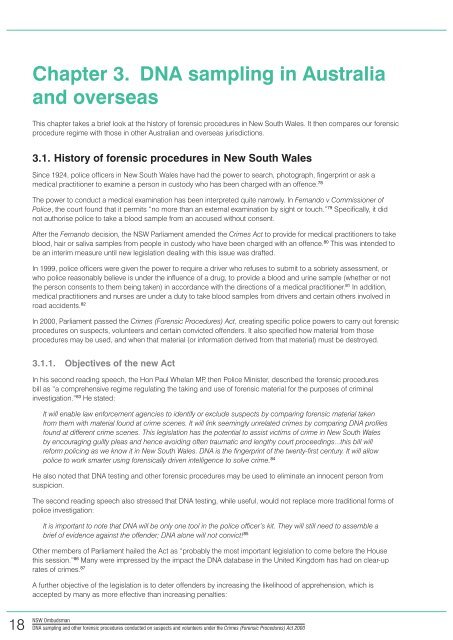Crimes (Forensic Procedures) Act 2000 - NSW Ombudsman - NSW ...
Crimes (Forensic Procedures) Act 2000 - NSW Ombudsman - NSW ...
Crimes (Forensic Procedures) Act 2000 - NSW Ombudsman - NSW ...
Create successful ePaper yourself
Turn your PDF publications into a flip-book with our unique Google optimized e-Paper software.
Chapter 3. DNA sampling in Australia<br />
and overseas<br />
This chapter takes a brief look at the history of forensic procedures in New South Wales. It then compares our forensic<br />
procedure regime with those in other Australian and overseas jurisdictions.<br />
3.1. History of forensic procedures in New South Wales<br />
Since 1924, police officers in New South Wales have had the power to search, photograph, fingerprint or ask a<br />
medical practitioner to examine a person in custody who has been charged with an offence. 78<br />
The power to conduct a medical examination has been interpreted quite narrowly. In Fernando v Commissioner of<br />
Police, the court found that it permits “no more than an external examination by sight or touch.” 79 Specifically, it did<br />
not authorise police to take a blood sample from an accused without consent.<br />
After the Fernando decision, the <strong>NSW</strong> Parliament amended the <strong>Crimes</strong> <strong>Act</strong> to provide for medical practitioners to take<br />
blood, hair or saliva samples from people in custody who have been charged with an offence. 80 This was intended to<br />
be an interim measure until new legislation dealing with this issue was drafted.<br />
In 1999, police officers were given the power to require a driver who refuses to submit to a sobriety assessment, or<br />
who police reasonably believe is under the influence of a drug, to provide a blood and urine sample (whether or not<br />
the person consents to them being taken) in accordance with the directions of a medical practitioner. 81 In addition,<br />
medical practitioners and nurses are under a duty to take blood samples from drivers and certain others involved in<br />
road accidents. 82<br />
In <strong>2000</strong>, Parliament passed the <strong>Crimes</strong> (<strong>Forensic</strong> <strong>Procedures</strong>) <strong>Act</strong>, creating specific police powers to carry out forensic<br />
procedures on suspects, volunteers and certain convicted offenders. It also specified how material from those<br />
procedures may be used, and when that material (or information derived from that material) must be destroyed.<br />
3.1.1. Objectives of the new <strong>Act</strong><br />
In his second reading speech, the Hon Paul Whelan MP, then Police Minister, described the forensic procedures<br />
bill as “a comprehensive regime regulating the taking and use of forensic material for the purposes of criminal<br />
investigation.” 83 He stated:<br />
It will enable law enforcement agencies to identify or exclude suspects by comparing forensic material taken<br />
from them with material found at crime scenes. It will link seemingly unrelated crimes by comparing DNA profiles<br />
found at different crime scenes. This legislation has the potential to assist victims of crime in New South Wales<br />
by encouraging guilty pleas and hence avoiding often traumatic and lengthy court proceedings...this bill will<br />
reform policing as we know it in New South Wales. DNA is the fingerprint of the twenty-first century. It will allow<br />
police to work smarter using forensically driven intelligence to solve crime. 84<br />
He also noted that DNA testing and other forensic procedures may be used to eliminate an innocent person from<br />
suspicion.<br />
The second reading speech also stressed that DNA testing, while useful, would not replace more traditional forms of<br />
police investigation:<br />
It is important to note that DNA will be only one tool in the police officer’s kit. They will still need to assemble a<br />
brief of evidence against the offender; DNA alone will not convict! 85<br />
Other members of Parliament hailed the <strong>Act</strong> as “probably the most important legislation to come before the House<br />
this session.” 86 Many were impressed by the impact the DNA database in the United Kingdom has had on clear-up<br />
rates of crimes. 87<br />
A further objective of the legislation is to deter offenders by increasing the likelihood of apprehension, which is<br />
accepted by many as more effective than increasing penalties:<br />
18<br />
<strong>NSW</strong> <strong>Ombudsman</strong><br />
DNA sampling and other forensic procedures conducted on suspects and volunteers under the <strong>Crimes</strong> (<strong>Forensic</strong> <strong>Procedures</strong>) <strong>Act</strong> <strong>2000</strong>

















